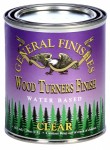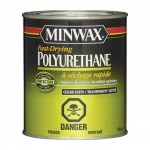Clear Coats
Finishing is one of the most daunting tasks a woodworker is faced with. Dovetails seem easy when it comes to finishing. So the question comes next, “What type of finish do I choose?”
There are three types of wood finishes: Reactive, Evaporative, and coalescing.
Reactive finishes use thinners such as mineral spirits and naphtha. These finishes undergo a chemical change when they cure. The molecule links are so strong they can not be broken by applying thinner. There are two categories that reactive finishes fall under: those that cure by oxygen and those that cure by a catalyst. The types of reactive finishes are:
Click on one to learn more about it.
 Evaporative finishes have solvents such as, alcohol, acetone, and laquer thinner. These finishes are made up of long, spaghetti-like molecules. These molecules pack together and interlock when the solvent evaporates. When a solvent is reintroduced the molecules can separate again and return to a liquid form. The types of evaporative finishes are:
Evaporative finishes have solvents such as, alcohol, acetone, and laquer thinner. These finishes are made up of long, spaghetti-like molecules. These molecules pack together and interlock when the solvent evaporates. When a solvent is reintroduced the molecules can separate again and return to a liquid form. The types of evaporative finishes are:
Click on one to learn more about it.
 Coalescing finishes use glycol ether as a solvent and water as a thinner. Majority of these finishes are water based. Tiny dispersions of cured finish are emulsified in water and glycol ether is added so that the droplets come together and form the finish. As the solvent evaporates, which is much slower than the water, the droplets start to react with each other forming one single layer. Because of this process it takes much longer for the finish to fully cure. Such finishes are:
Coalescing finishes use glycol ether as a solvent and water as a thinner. Majority of these finishes are water based. Tiny dispersions of cured finish are emulsified in water and glycol ether is added so that the droplets come together and form the finish. As the solvent evaporates, which is much slower than the water, the droplets start to react with each other forming one single layer. Because of this process it takes much longer for the finish to fully cure. Such finishes are:
Click on one to learn more about it.
